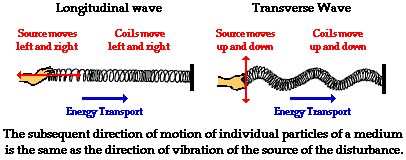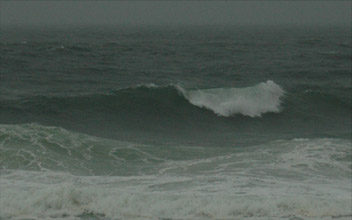Wave motion
Wave motion is defined as the movement of a distortion of a material or medium, where the individual parts or elements of the material only move or propogate back-and-forth, up-and-down, or in a cyclical pattern.It is just the distortion moving, where one part influences the next.

Example:

Probably the most familiar example of wave motion is the action of water waves. A boat at rest on the ocean moves up and down as water waves pass beneath it. The waves appear to be moving toward the shore. But the water particles that make up the wave are actually moving in a vertical direction. The boat itself does not move toward the shore or, if it does, it's at a much slower rate than that of the water waves themselves.
The energy carried by a water wave is obvious to anyone who has watched a wave hit the shore. Even small waves have enough energy to move bits of sand. Much larger waves can, of course, tear apart the shore and wash away homes.
Other Examples:
Wave motion on rope

A rope is fixed with one end to a wall and moving the other end up and down.Up and Down movements produce a vibration and oscillation.The rope waves produced move towards the wall while traveling up and down.In this case, the rope is the medium through which the waves move.The kinetic energy from the up-and-down movement is transferred by the wave without the rope itself moving from one end to another.
Waves in a ripple tank



In a ripple tank, a small dipper moves up and down the water surface.As a result, the water particles at the surface that are in contact with the dipper are made to move up and down.This up and down motion spreads to other parts of the water surface in the tank in the form of ripples.The kinetic energy from the up and down movement of the dipper is transferred to the water molecules in the surface.These water molecules then transfer the energy to the surrounding water molecules and so on.(Note: on the energy is transferred from the dipper to the water, not the water itself)

In a Nutshell...
We know that:
1.The source of a wave is a vibration or oscillation (Basically a disturbance to the medium)
2.Waves transfer energy from one point to another.
3.In waves,energy is transferred without the medium being transferred
No comments:
Post a Comment